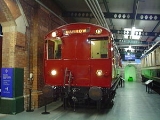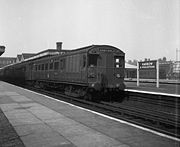
LNWR electric units
Encyclopedia

London and North Western Railway
The London and North Western Railway was a British railway company between 1846 and 1922. It was created by the merger of three companies – the Grand Junction Railway, the London and Birmingham Railway and the Manchester and Birmingham Railway...
embarked on a project to electrify their London inner-suburban network, encompassing the lines from London Euston to Watford
Watford Junction railway station
On 23 January 1975, an express train from Manchester to Euston derailed just south of Watford Junction after striking some stillages that had fallen on to the track. It then collided with a sleeper service from Euston to Glasgow. The driver of the Manchester train was killed, and eight passengers...
and the North London Railway
North London Railway
The North London Railway was a railway company that opened lines connecting the north of London to the East and West India Docks. The main east to west route is now part the North London Line. Other lines operated by the company fell into disuse, but were later revived as part of the Docklands...
from London Broad Street to Richmond
Richmond station (London)
Richmond station is a National Rail and London Underground station in the London Borough of Richmond upon Thames in south west London which is managed by South West Trains....
, including branch lines such as Watford to Croxley Green
Croxley Green railway station
Croxley Green is a disused railway station near Watford, outside London, UK. It is located between Watford and the village of Croxley Green to the west of Watford, at the end of a short branch line.-History:...
(where a depot was built to house the electric units), and links to what was to become the London Underground
London Underground
The London Underground is a rapid transit system serving a large part of Greater London and some parts of Buckinghamshire, Hertfordshire and Essex in England...
network. For this reason, the lines were electrified at 630 V DC fourth rail, the electricity being generated at the LNWR's power station in Stonebridge Park. The first electric passenger trains ran in 1914, on the West London Line
West London Line
The West London Line is a short railway in inner West London which links lines at in the south to lines near Willesden Junction in the north. It has always been an important cross-London link especially for freight services...
route (Willesden
Willesden Junction station
Willesden Junction station is a Network Rail station in Harlesden, northwest London, UK. It is served by both London Overground and the Bakerloo line of the London Underground.-History:The station developed on three contiguous sites:...
to Earls Court
Kensington (Olympia) station
Kensington station is a station in West London managed and served by London Overground and also served by Southern and London Underground. It is in Travelcard Zone 2...
), but full services over the whole network did not commence until 1922, work having been delayed by the First World War. The London, Midland and Scottish Railway
London, Midland and Scottish Railway
The London Midland and Scottish Railway was a British railway company. It was formed on 1 January 1923 under the Railways Act of 1921, which required the grouping of over 120 separate railway companies into just four...
extended the network in 1927, by electrifying the branch to Rickmansworth.
The electric units
The LNWR placed orders for three-car electric multiple unitElectric multiple unit
An electric multiple unit or EMU is a multiple unit train consisting of self-propelled carriages, using electricity as the motive power. An EMU requires no separate locomotive, as electric traction motors are incorporated within one or a number of the carriages...
s from Metropolitan-Cammell in Birmingham
Birmingham
Birmingham is a city and metropolitan borough in the West Midlands of England. It is the most populous British city outside the capital London, with a population of 1,036,900 , and lies at the heart of the West Midlands conurbation, the second most populous urban area in the United Kingdom with a...
. These units were formed Driving Motor Brake Third (DMBT) + Trailer Composite (TC) + Driving Trailer Brake Third (DTBT). All the cars were open saloons and the electrical equipment was in a compartment behind the driving cab in the DMBT.
The units were delivered in three batches. The first batch, introduced in 1914, was fitted with electrical equipment from Siemens of Germany
Germany
Germany , officially the Federal Republic of Germany , is a federal parliamentary republic in Europe. The country consists of 16 states while the capital and largest city is Berlin. Germany covers an area of 357,021 km2 and has a largely temperate seasonal climate...
. Due to the War, the following two batches, introduced in 1915 and 1921, used equipment from Oerlikon of Switzerland
Switzerland
Switzerland name of one of the Swiss cantons. ; ; ; or ), in its full name the Swiss Confederation , is a federal republic consisting of 26 cantons, with Bern as the seat of the federal authorities. The country is situated in Western Europe,Or Central Europe depending on the definition....
.
In 1927, the LMS ordered a further batch of units from Metropolitan-Cammell to cover additional passenger services. These were broadly similar to the earlier units, but this time were fitted with more powerful Metropolitan Vickers (owned by GEC) electrical equipment. Also, the passenger accommodation was in compartments.
Numbering
The LMS numbers of the Siemens stock were:- DMBT, 28219–28222
The LMS numbers of the Oerlikon stock were:
- DMBT, 28000, 28223–28299 (282236 is missing from the list in the source)
The British Railways numbers of the 1927 compartment stock were:
- DMBT (later Motor Brake Second), M28001M–M28025M
- TC (later Trailer Second), M29401M–M29409M and M29600M–M29625M
- DTBT (later Driving Trailer Brake Second), M28800M–M28824M
Operation
The LNWR electric lines built up to a substantial operation, at its peak in the 1930s-50s period, and then ran into a major decline.The two basic main services were Euston to Watford Junction, and Broad Street to Richmond, the latter passing over the former at Willesden Junction station. In addition there was a substantial operation of Broad Street to Watford Junction trains via Primrose Hill, which shared significant sections of both main routes.
There were lesser branches from Willesden Junction to Earls Court (closed in WW2), Watford to Rickmansworth (closed in 1952) and Watford to Croxley Green (closed in 1990). The Earls Court route was the normal operation for the four pioneer Siemens-equipped trains.
In an early 1950s timetable there were substantial peak period electric services on the main routes. Departing between 5pm and 6pm there were four trains in the hour on Broad Street to Richmond (the “North London line”), five in the hour on Euston to Watford (the “DC line”), and seven in the hour on Broad Street to Watford. All these were scheduled for 6-car trains. A small number of the peak hour Watford line trains were operated at the northern end directly to Croxley Green instead of to Watford Junction. In addition certain trains from the Bakerloo Line of the Underground ran over the line from Queens Park to Harrow & Wealdstone or Watford Junction. The services were not on a particularly regular interval basis as there was the need for them to interleave with many other operations, and each other; in addition some trains were on a semi-fast basis, or skipped certain stations.
The Croxley and Rickmansworth lines were normally operated by 3-car shuttle trains. The pre-war Earls Court trains had been similar.
The combined frequency of the electric trains from South Hampstead to Watford was thus about every five minutes, and the through Bakerloo trains were additional to this. This very substantial operation (compared to later years) was behind the installation of the pioneer automated signalling system in 1933, which lasted until 1988 when replaced by a conventional system, by which time services were substantially reduced. The 1933 signalling system had allowed scheduled headways of two mnutes on the route.
Withdrawal
The Siemens stock were stored during World War IIWorld War II
World War II, or the Second World War , was a global conflict lasting from 1939 to 1945, involving most of the world's nations—including all of the great powers—eventually forming two opposing military alliances: the Allies and the Axis...
due to the closure of the West London Line route to passenger trains following bomb damage. In 1952, they were converted as prototype 25 kV AC overhead EMUs (Class AM1
British Rail Class AM1
Class AM1 was allocated to the prototype AC electric multiple units, converted from fourth-rail DC electric stock in 1952 and used on the Lancaster/Morecambe/Heysham route...
). These units survived in use on the Lancaster-Morecambe
Morecambe
Morecambe is a resort town and civil parish within the City of Lancaster in Lancashire, England. As of 2001 it has a resident population of 38,917. It faces into Morecambe Bay...
-Heysham
Heysham
Heysham is a large coastal village near Lancaster in the county of Lancashire, England. Overlooking Morecambe Bay, it is a ferry port with services to the Isle of Man and Ireland. Heysham is the site of two nuclear power stations which are landmarks visible from hills in the surrounding area...
line until 1966.
The Oerlikon and GEC stock survived in service in North London through to the late 1950s and early 1960s respectively, when they were replaced by the new Class 501
British Rail Class 501
The British Rail Class 501 electric multiple units were built in 1957/58 for use on the former LNWR/LMS suburban electric network of the London Midland Region...
units. Only one car survives, Oerlikon-equipped DMBT 28249, at the National Railway Museum
National Railway Museum
The National Railway Museum is a museum in York forming part of the British National Museum of Science and Industry and telling the story of rail transport in Britain and its impact on society. It has won many awards, including the European Museum of the Year Award in 2001...
, York
York
York is a walled city, situated at the confluence of the Rivers Ouse and Foss in North Yorkshire, England. The city has a rich heritage and has provided the backdrop to major political events throughout much of its two millennia of existence...
.
Sources
- Ian Allan ABC of Southern and LMS Electrics, 1945 edition, page 33
- Ian Allan ABC of British Railways Locomotives, winter 1962/3 edition, page 324

